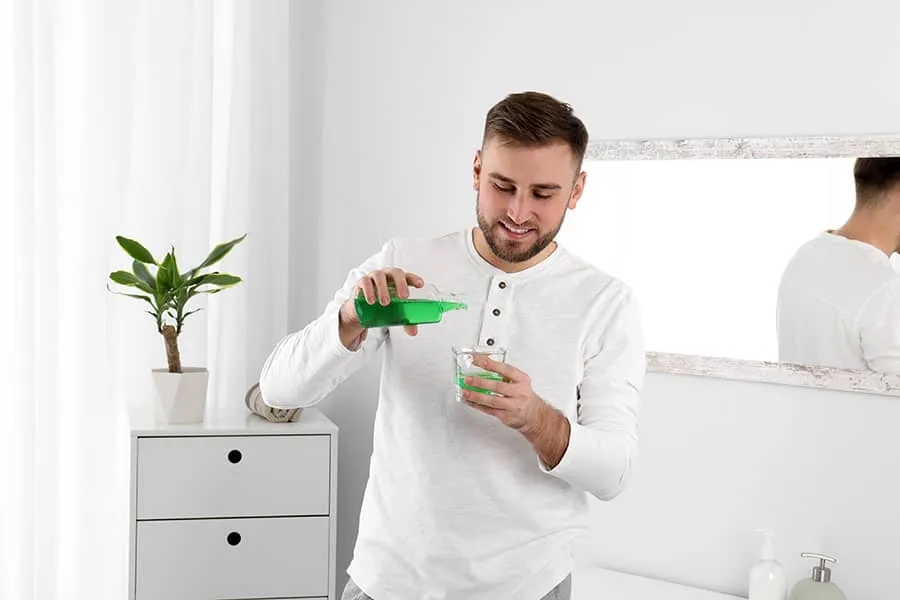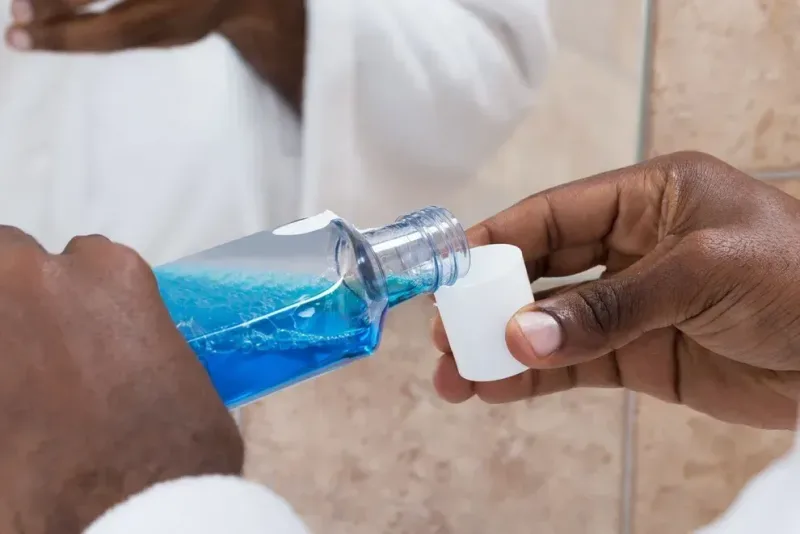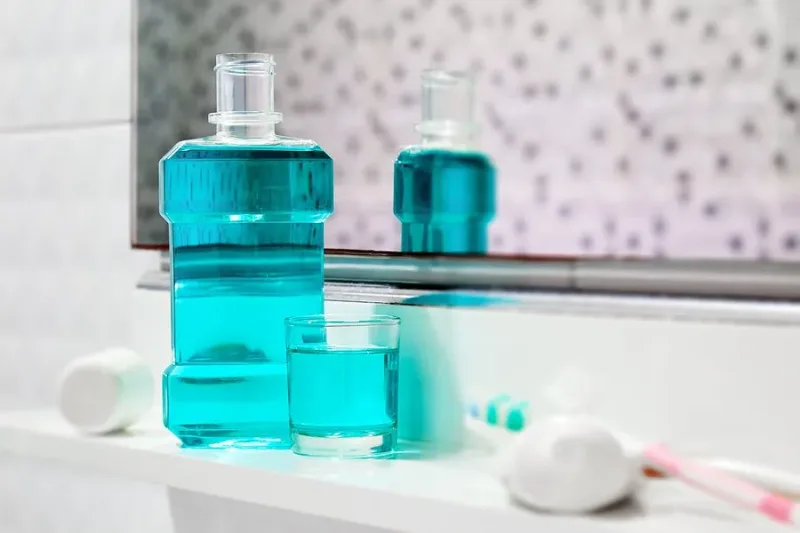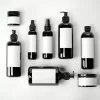Chlorhexidine gluconate is a powerful antiseptic ingredient used in mouthwash to fight the bacteria responsible for gum diseases like gingivitis. While highly effective in reducing dental plaque and gum inflammation, it is crucial to be aware of possible side effects such as teeth staining, altered taste, and increased tartar buildup. This blog explores how chlorhexidine gluconate mouthwash works, its benefits, and the precautions to consider, ensuring informed usage under dental supervision.
Key Takeaways
- Chlorhexidine effectively kills bacteria in your mouth that lead to gum disease, making it a potent antiseptic mouthwash.
- Dentists prescribe it to manage symptoms of gingivitis, such as inflammation, swelling, and bleeding.
- However, chlorhexidine may cause staining of teeth and tongue, alter your taste perception, and increase tartar buildup. Your dentist will assist you in weighing the pros and cons, helping you make a decision that is best suited to your dental health needs.
What is chlorhexidine gluconate?
Chlorhexidine gluconate is a germicidal mouthwash that effectively reduces bacteria in the mouth. It is primarily prescribed by dentists to treat gingivitis, which includes symptoms such as swelling, redness, and bleeding gums.
However, it’s important to note that this mouthwash is not suitable for all types of gingivitis. You should use chlorhexidine gluconate oral rinse only for the prescribed condition. Additionally, do not share this medication with others, even if they exhibit similar symptoms. Furthermore, chlorhexidine gluconate may be used for other purposes not mentioned in the medication guide.

How chlorhexidine gluconate works
Chlorhexidine gluconate is a powerful antimicrobial that eliminates bacteria throughout the mouth. It can be applied in various forms; if prescribed as a mouthrinse by your dental or medical professional, make sure to follow the provided directions carefully.
Furthermore, a study published in the Journal of Indian Society of Periodontology indicates that chlorhexidine gluconate can also be applied directly under the gumline, either at home or during a professional appointment.
What are the benefits of Chlorhexidine Gluconate Mouthwash?
Chlorhexidine mouthwash comes with a list of benefits, such as:

Antibacterial properties
Chlorhexidine mouthwash is a potent antibacterial agent that eliminates the germs responsible for gum disease. It is commonly prescribed by dentists to address symptoms like bleeding, swelling, and inflammation associated with gingivitis.
Protective barrier
During dental treatments, chlorhexidine creates a protective barrier over your gums and teeth. This barrier prevents plaque buildup for up to 12 hours, aiding in both the treatment and prevention of gum disease and oral infections. Additionally, it can relieve symptoms of mouth ulcers and sore throats.
Research-supported benefits
Research supports the supplemental short-term use of chlorhexidine in managing dental plaque, minimizing clinical symptoms of dry socket and gingivitis, and reducing the aerosolization of bacteria during dental procedures.
Chlorhexidine Gluconate mouthwash side effects
Chlorhexidine gluconate has three main side effects, so you should consider before using it.
Staining
Chlorhexidine can cause several side effects, one of which is staining. It has the potential to stain tooth surfaces, dental restorations, and even the tongue. Although most stains can be removed with thorough dental cleaning, it’s important to consider this effect, especially if you have many front teeth with white fillings. In such cases, your dentist might decide against chlorhexidine to avoid these cosmetic concerns.
Alteration in taste
Another side effect involves an alteration in taste. Some individuals notice a change in how things taste while using chlorhexidine, and although this is usually temporary, there are rare instances where the altered taste may become permanent after the treatment is done.
Tartar formation
Using chlorhexidine might lead to an increase in tartar formation on your teeth. This buildup can contribute to further dental issues, necessitating more frequent dental cleanings and potentially complicating oral hygiene. Therefore, it’s essential to weigh these potential side effects against the benefits of using chlorhexidine as part of your dental care routine.
Who can and cannot use chlorhexidine
Here is how to use chlorhexidine digluconate mouthwash effectively:

- Usage Guidelines: Chlorhexidine products, including throat sprays, lozenges, and dental treatments like mouthwash and dental gel, are suitable for adults and children aged 12 and older. Chlorhexidine skin treatments are available for both adults and children of any age.
- Safety Precautions: Before using chlorhexidine, it is crucial to consult with a pharmacist or doctor if you have had allergic reactions to chlorhexidine or any other ingredients in the past. Additionally, disclose if you’ve ever had an allergic reaction to any other medicine.
- Alcohol Content Concerns: If you cannot consume or need to avoid alcohol, be aware that some chlorhexidine sprays and mouthwashes may contain small amounts of alcohol. It is advisable to ask a pharmacist, doctor, or dentist for alternatives that do not contain alcohol.
How and when to use chlorhexidine digluconate mouthwash
Here’s a guide to using various chlorhexidine treatments effectively:
General Instructions
- Always follow the instructions provided with over-the-counter chlorhexidine products or adhere to the advice from your healthcare provider for prescription treatments.
- Before and after using any chlorhexidine product, wash your hands thoroughly.
- Avoid contact with eyes and ears. If chlorhexidine accidentally gets into these areas, rinse well with water.
Dosage and Application
-
Lozenges
- Children (12+): Up to 5 lozenges per day.
- Adults: Up to 10 lozenges per day.
- Place a lozenge in your mouth and allow it to dissolve slowly. Avoid eating or drinking for 30 to 60 minutes afterward.
-
Mouthwash
- Dose: 10 ml, used twice daily.
- Pour 10 ml into the measuring cup, rinse around your mouth for about 1 minute, then spit it out. Avoid ingestion. Wait 30 to 60 minutes before eating or drinking.
-
Mouth Spray
- Dose: 2 squirts, up to 12 times a day.
- Aim the spray at the affected area in your mouth. Do not eat or drink for the next 30 to 60 minutes.
-
Throat Spray
- Dose: 3 to 5 squirts, up to 10 times a day.
- Spray directly onto the sore throat area and avoid eating or drinking for 30 to 60 minutes.
-
Dental Gel
- Apply once or twice daily using a fingertip or cotton bud to gently wipe the gel across the sore part of your mouth. Avoid food and drink for 30 to 60 minutes afterward.
-
Sore Throat Treatments
- Use lozenges and throat spray only for a short duration. If symptoms do not improve after 3-4 days, consult a doctor.
-
Dental Treatments
- Use chlorhexidine at a different time from brushing your teeth, as toothpaste can reduce its effectiveness. If needed, rinse your mouth thoroughly with water after brushing and wait at least 5 minutes before applying chlorhexidine.
- If symptoms do not improve or worsen within a week, stop use and consult your dentist or doctor.
Following these refined instructions can help ensure the effective and safe use of chlorhexidine treatments.
Chlorhexidine warnings
When using chlorhexidine after your dentist prescribes it, consider discussing the following points:
- Allergic Reactions: Avoid using chlorhexidine if you are allergic, as it can cause serious reactions.
- Dosage: Adhere to your dentist’s instructions—typically 0.5 fluid ounces, undiluted, twice daily for 30 seconds.
- Ingestion: After rinsing, spit it out. Do not swallow.
- Timing: Use chlorhexidine after brushing your teeth. Avoid brushing again, rinsing with water, or eating immediately afterward.
- Periodontitis: While effective for gingivitis, chlorhexidine does not treat periodontitis and may worsen it.
- Pregnancy: Inform your dentist if you are pregnant or planning to become pregnant, as its safety for a fetus is not established.
- Breastfeeding: Discuss with your dentist if you are breastfeeding since it is unknown whether chlorhexidine affects breast milk or the baby.
- Follow-Up: Schedule regular evaluations with your dentist to monitor the treatment’s effectiveness, ideally every six months.
- Dental Hygiene: Chlorhexidine is not a substitute for brushing, flossing, or regular dental check-ups.
- Children: Chlorhexidine is not approved for children under 18.
So, What UK Supplement manufactures the Chlorhexidine digluconate mouthwash?
In the UK, several manufacturers might be capable of producing chlorhexidine digluconate mouthwash under a private label. Companies specializing in producing pharmaceutical and oral care products are often equipped to offer such services, accommodating a range of formulations including chlorhexidine-based products. Here is a notable manufacturer – UKSupplementmanufacturer you might consider.

UK Supplementmanufacturer is a specific company that manufactures chlorhexidine digluconate mouthwash among other products.
UK Supplement is a distinguished manufacturer within the United Kingdom specializing in the production of dietary supplements and healthcare products, including oral care products like chlorhexidine digluconate mouthwash. The company is known for its commitment to quality and safety, adhering to strict regulatory standards to ensure their products meet the highest industry benchmarks.
UK Supplement offers a range of services including private label manufacturing, which allows clients to market chlorhexidine mouthwash under their own brand names. This capability makes the UK Supplement a versatile and attractive partner for businesses looking to expand their product lines in the oral healthcare market. The company leverages advanced manufacturing technologies and employs a team of experts to develop and produce formulations that effectively address various health and wellness needs.
In Conclusion
Chlorhexidine digluconate mouthwash is highly regarded for its effective antibacterial properties, making it a staple in dental hygiene routines for those looking to combat gum disease and maintain oral health. Its ability to significantly reduce dental plaque and treat gingivitis symptoms like swelling, redness, and bleeding makes it a trusted choice prescribed by dental professionals. However, users should be mindful of potential side effects such as teeth staining, altered taste, and increased tartar formation.
Chlorhexidine Digluconate in Mouthwash: FAQs
Can chlorhexidine mouthwash be used everyday?
Your dentist will advise on the specific duration, based on your oral health needs.
How long should chlorhexidine be used?
Generally, chlorhexidine should be used for about two weeks. Prolonged use can lead to side effects like staining and altered taste; therefore, it’s important to follow your dentist’s instructions.
How effective is chlorhexidine gluconate?
Chlorhexidine gluconate is highly effective as an antimicrobial agent. It efficiently reduces bacterial levels in the mouth, significantly lowering the risk of gum disease and helping to manage gingivitis.
What are the contraindications to recommending chlorhexidine rinses?
Chlorhexidine rinses are not recommended for individuals with known allergies to chlorhexidine. Moreover, its use should be cautious in those who cannot consume alcohol, as some formulations contain ethanol. Additionally, due to potential staining, people with a high number of dental restorations might prefer alternative treatments.











One comment on “Is Chlorhexidine Gluconate Mouthwash Right for You? Find Out!”
Pingback:
Top 5 UK Cooling Gel Products You “Must" Try